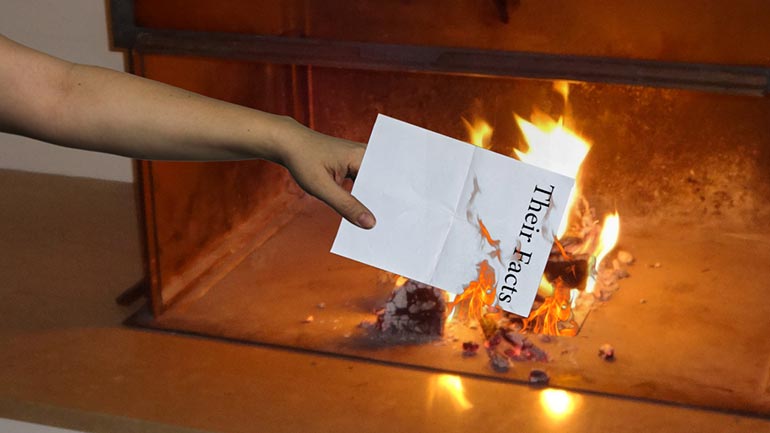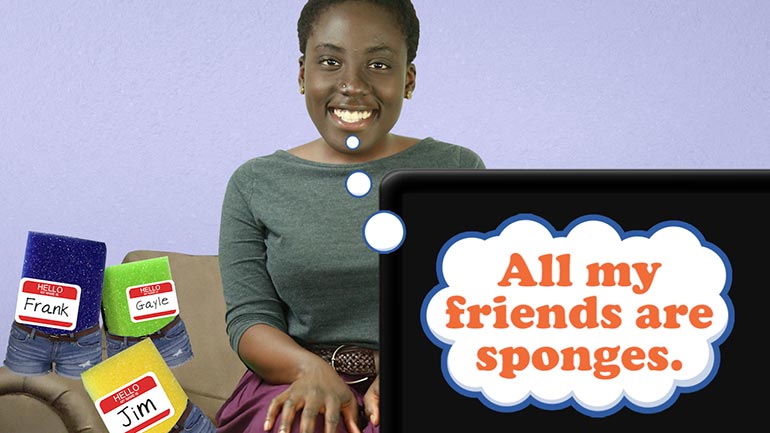ShmoopTube
Where Monty Python meets your 10th grade teacher.
Search Thousands of Shmoop Videos
Math 5: Place Value 175 Views
Share It!
Transcript
- 00:13
So you can count to nine, right?
- 00:15
Y'know, 0, 1, 2, 3, 4, 5, 6, 7, and 8. [Girl counting]
- 00:19
…Why no nine?
- 00:20
Because seven…eight…nine….heh.
- 00:21
Okay, we're just joking, 9 is alive and well. [The number 7 sat at a table in a diner]
Full Transcript
- 00:25
And with just those ten digits, we're able to represent numbers way bigger than just
- 00:30
ten.
- 00:31
Which is definitely a good thing…you wouldn't want your paycheck to say "$9…plus some [Picture of a pay check]
- 00:35
more, we guess."
- 00:36
And it's all thanks to the magic of place values.
- 00:39
The idea of place values is pretty simple.
- 00:41
We count up from zero using our regular digits, but once we run out, aka once we get to 9, [Scoreboard counting up]
- 00:46
we tack on a new place value.
- 00:48
So if we have 9, and we want to go up by one, we replace the 9 with a 0, and put a 1 to
- 00:53
the left.
- 00:54
The 0 is holding the ones place value…
- 00:56
…while the 1 is holding the tens place value. [Arrows pointing to the place values]
- 00:59
And since saying, "8, 9, 1 in the tens place value and zero in the ones place value," gets
- 01:04
kinda clunky, we just call it "ten." [Long description gets crossed out]
- 01:06
Without place values, we'd need new symbols for each new number, and if you think math
- 01:11
is hard now, try doing it when you need to remember millions of different, tiny symbols. [Random symbols appear and girl runs away]
- 01:15
Calculators would need to be the size of huge playgrounds. [Girl jumping on a big calculator]
- 01:18
Boring, mathy playgrounds.
- 01:20
The place values are all organized around powers of ten. [Coop pointing to a blackboard]
- 01:23
Each time we add a new place value to the left, we're multiplying the last one by ten.
- 01:27
We start with ones…
- 01:29
…then multiply that by ten to get tens…
- 01:32
…then multiply that by ten to get to the hundreds…
- 01:34
…then multiply that by ten to get to the thousands…
- 01:37
…then, well, we think you get the idea.
- 01:39
We could keep doing this for a really, really long time.
- 01:43
However, let's not…we don't want this video to never end, we have lunch plans. [Guy apologies for being late to lunch]
- 01:47
These place values give us a very simple way to understand what's going into our numbers.
- 01:51
Take 2,074, for example.
- 01:54
In the ones place, we see a 4.
- 01:56
So 2,074 definitely contains 4.
- 01:59
When we move over to the tens, we see a 7, so 2,074 also contains 7 times 10, aka 70. [Each component of the number is highlighted]
- 02:06
Next, when we look at the hundreds we see a 0.
- 02:09
Sorry, 2,074, but that means you contain 0 times 100, or a big, fat 0.
- 02:15
But no need to despair.
- 02:17
In the thousands we see a two, so 2,074 also contains 2 times 1,000 which is 2,000.
- 02:23
And, surprise surprise, if we add up those four numbers, we get—drumroll—2,074.
- 02:30
Which is a much nicer number to see on a pay check. [Paycheck with $2,074 on it]
- 02:32
And if you're ever confused about what a certain place value represents, just look for the [Boy holding a teddybear looks confused]
- 02:36
decimal point. [Arrow pointing to the decimal point on a price tag]
- 02:37
It always sits just to the right of the ones, which is a pretty cozy spot if you ask us.
- 02:41
So if you have $26,000, that's enough money to buy a pretty good speedboat… [ATM showing $26,000]
- 02:46
…but if that decimal point hops four places to the left, you're down to $2.60…
- 02:50
…which is only enough to buy a pretty blah sandwich. [ATM showing $2.60]
- 02:53
And we definitely wouldn't recommend taking it out on the lake for a spin. [Woman stood on a sandwich in the lake sinks]
Up Next
Check out the best bias video ever made, courtesy of the most awesome and amazing educational website in existence.
Related Videos
No, this isn't a terrible new mint-peach bubble gum flavor...though it does tend to leave a bad taste in people's mouths.
Those settlers in Jamestown really should have settled down with all that land-stealing. Tobacco's bad for you anyway.
Being born out of multiple wars doesn't quite seem to fit the peaceful, polite Canadians we know and love today...oh wait, they were called The Bea...
Not every cartoon is meant to entertain small children while their mother gets some "Mommy time." There are also political cartoons, which are mean...




